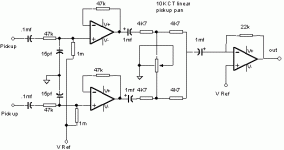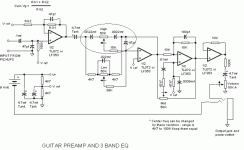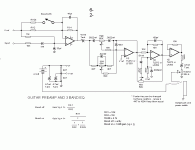As far as I remember, the correct way to do a pan control is with a stacked pot, and I'm not real fond of dual volume controls. Also, can you give me some ballpark values for the resisters that would work well in a 5-string-keeping in mind that the B string, at 30Hz, is the hardest to bring out.
Just curious, is this circuit an active tone circuit?
thanks,
Corey
Just curious, is this circuit an active tone circuit?
thanks,
Corey
ccreddell said:As far as I remember, the correct way to do a pan control is with a stacked pot, and I'm not real fond of dual volume controls.
Not the 'correct' way, just one alternative, and as you say a dual pot is a major disadvantage of that method.
The circuit below should work fine for panning pickups. The Vref is shown on the active preamp I have posted on this thread. The summing amplifier could be incorporated as the first amp in the active preamp I have posted and gain set with the feedback resistor.
Keep in mind the pan pot must be center-tapped for the pan to properly work.
Keep in mind the pan pot must be center-tapped for the pan to properly work.
Attachments
Brion55 said:
Keep in mind the pan pot must be center-tapped for the pan to properly work.
Works fine without the centre tap as well - it's how most such ciruits are connected.
Brion55 said:The circuit below should work fine for panning pickups. The Vref is shown on the active preamp I have posted on this thread. The summing amplifier could be incorporated as the first amp in the active preamp I have posted and gain set with the feedback resistor.
Keep in mind the pan pot must be center-tapped for the pan to properly work.
Thanks a lot! Now I have to start building. BTW do you have a number for the IC?
Corey
Nigel Goodwin said:
Not the 'correct' way, just one alternative, and as you say a dual pot is a major disadvantage of that method.
Sorry, I wasnt clear. What I meant was that I dont like having two discrete volume controls. A stacked pot doesnt bother me at all.
Corey
Now I'm confused! Are you saying thatccreddell said:
Sorry, I wasnt clear. What I meant was that I dont like having two discrete volume controls. A stacked pot doesnt bother me at all.
Corey
i) you would be happy with two separate volume controls, stacked but operable independently,
ii) you would be happy with separate single track volume and pan controls, stacked but operable independently?
I guess I'm having a hard time getting my thought across.
Let me try again;
I was of the understanding that dual pot on a common shaft with the pots being wired opposite of each other, but controlled by the same knob, (i.e. turning the knob turns one up and the other down at the same time, middle being both on full-just one knob) was the best way to do a panning control on a bass. (I appear to be wrong)
What I dont like, is having two volume controls on my bass (with seperate knobs, in different locations) that operate independently.
Brion set me straight on the pan pot, and I apologize for not making myself clear.
BTW Brion, did you have a chance to come up with R values for the bass control to deal with 30Hz?
Corey
Let me try again;
I was of the understanding that dual pot on a common shaft with the pots being wired opposite of each other, but controlled by the same knob, (i.e. turning the knob turns one up and the other down at the same time, middle being both on full-just one knob) was the best way to do a panning control on a bass. (I appear to be wrong)
What I dont like, is having two volume controls on my bass (with seperate knobs, in different locations) that operate independently.
Brion set me straight on the pan pot, and I apologize for not making myself clear.
BTW Brion, did you have a chance to come up with R values for the bass control to deal with 30Hz?
Corey
I think you are being hard on yourself there.ccreddell said:...I was of the understanding that dual pot on a common shaft with the pots being wired opposite of each other, but controlled by the same knob, (i.e. turning the knob turns one up and the other down at the same time, middle being both on full-just one knob) was the best way to do a panning control on a bass. (I appear to be wrong)...Corey
The dual pot on a common shaft has been one of the standard ways of panning/blending passive pickups since the early Jazz basses. It's still common in passive basses. I think I am right in saying that the one pot version came later, as people started to put electronics into their basses.
A lack of information?
Hello friends. Build this project but the high does not work! Can anyone help? This happened to anyone? Tested on my bottom, with the capacitors for bass. Big hug to everyone!
Attachments
use the switch to change resistor value in the feedback network.
Usually dropping another resistor in parallel with the feedback resistor (-in to ground, not the o/p to ground) should give you a gain boost, but it shouldn't overload the opamp or anything, so keep the value sensible.
If you're trying to vary gain using a pot you would need to ensure that if the pot decides to go to heaven at any point in time (wiper not conducting or wiper turned fully one way or the other) the minimum feedback ratio is maintained through fixed resistors, usually in series and parallel with the pot.
Hello Sangram. Help me please! Put RG1 RG2-10k-1M. But is distorting a bit. Could confirm if these values are correct? Thank you for listening!
use the switch to change resistor value in the feedback network.
Usually dropping another resistor in parallel with the feedback resistor (-in to ground, not the o/p to ground) should give you a gain boost, but it shouldn't overload the opamp or anything, so keep the value sensible.
If you're trying to vary gain using a pot you would need to ensure that if the pot decides to go to heaven at any point in time (wiper not conducting or wiper turned fully one way or the other) the minimum feedback ratio is maintained through fixed resistors, usually in series and parallel with the pot.
Grateful for having responded Sangram. It is this project. I do not have much knowledge in electronics infeizmente, but thank you if you could explain to me in simple terms.
Attachments
- Status
- This old topic is closed. If you want to reopen this topic, contact a moderator using the "Report Post" button.
- Home
- Live Sound
- Instruments and Amps
- 2-band bass guitar onboard preamp


